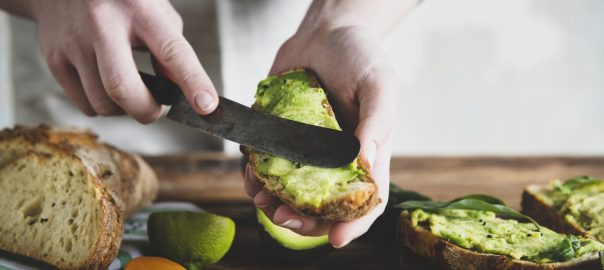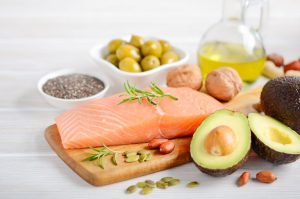
Good vs. Bad Fats: Know The Difference
Breaking down the difference between good and bad fats.
Fat: What is it?
Fat is one of three macronutrients that your body needs on a daily basis in order to function. These are fats, proteins and carbohydrates. Good fats help the body absorb nutrients from fat-soluble vitamins, such as vitamins A, D, E and K. They also keep the skin healthy and are the main way the body stores energy. On the flip side, consuming bad fats increases cholesterol levels and creates inflammation which can result in a number of chronic diseases.
All fat molecules are made from fatty acids and glycerol. Most fats are triglycerides (glycerol and three fatty acids), but despite similar chemical structures, they do not all behave the same. Some fats are solid at room temperature and some are liquid. This gives some indication of their smoke point and stability (i.e. how quickly they break down when you cook with them). Some fats will last a long time in your pantry, while others will go rancid quickly. Oils that have gone rancid can lose their nutritional properties,
It can be confusing to learn all the differences, but we’re here to breakdown the good and the bad – especially if you are on a fat-based diet!
The Different Types Of Fats
The amount of fat we eat doesn’t impact our weight, cholesterol, or risk of heart disease nearly as much as what kind of fat we eat. That is why it is important to know the types of fats you are consuming to spot the differences between good (healthy) fats and bad (unhealthy) fats. It is also important to point out that foods advertised as “low fat” or “no fat” have probably undergone some kind of refining process that actually puts them in the “bad” category; avoid these foods.
There are three major types: unsaturated fats, saturated fats and trans fats.
Unsaturated Fats (Good)
Unsaturated fats get the green light go ahead! Consuming unsaturated fats can reduce the risk of high blood cholesterol levels. They are usually liquid at room temperature, unlike saturated fats which tend to be solid.
Healthy unsaturated fats come in two main forms: polyunsaturated and monounsaturated.
Polyunsaturated Fats (Good)
There are two types of polyunsaturated fats: omega-3 and omega-6. You have probably heard of these fats and have probably been encouraged to eat more of them, especially omega-3s as these can help lower inflammation and promote cognitive and cardiovascular health. These two fats act differently in the body, and you need both. However, the balance is key. Experts recommend a ratio of omega-6 to omega-3 fats in the diet of 4:1 or less. The reality is that most of our foods are higher in omega-6s (Western diets have a ratio between 10:1 and 50:1!), so it is important to consume more foods rich in omega-3s such as those listed below.
Plant sources of omega-3:
- Flaxseed
- Walnuts
- Chia seed
- Brussel sprouts
- Hemp seed
- Soy (Edamame, Soybean Oil, Tofu)
- Canola oil (look for non-hydrogenated, non-GMO)
- Seaweed and Microalgae such as spirulina and chlorella
Marine sources of omega-3:
- Coldwater fish such as mackerel, salmon, seabass, oysters, shrimp and trout
- Fish and krill oil supplements
- Cod liver oil
- Algae oil
Plant sources of omega-3 contain ALA (antioxidant, lowers blood sugar levels, reduces inflammation, slows skin aging, improves nerve function), while marine sources contain DHA and EPA (reduce inflammation and risk of chronic disease). We need all of these compounds in our bodies, and one type alone is not a supplement for the other.
Omega-6 also occurs in a lot of foods that also contain omega-3s such as nuts and seeds, avocado, eggs, and tofu. However, you will also find high levels of omega-6s in processed foods, meats and cheeses. If you’re on a fat-based diet like keto, some sources will recommend you to load up on bacon, steak, hamburgers, cheeses, and other lower-quality fats, but with these foods, your omega-6 levels will go through the roof! Stick to consuming both plant and marine sources of omega-3s as these will already contain the amounts of omega-6s you need.
Monounsaturated Fats (Good)
Monounsaturated fats can improve the function of blood vessels, reducing the risk of cardiovascular disease. Some research also shows that they can help control insulin and blood sugar levels, which can help you manage type 2 diabetes.
Some examples of foods rich in monounsaturated fats are:
- Avocados
- Nuts such as almonds, cashews, pecans, macadamia, and peanuts.
- Cooking oils made from plants or seeds like canola, olive, peanut, soybean, sesame and sunflower oils.
- Olives
They key is to consume polyunsaturated and monounsaturated fats instead of lower quality fats, not in addition to them. Below is a look at some of the bad fats out there. The good thing is that these are easy to spot since they are listed on ever nutrition facts table. Make sure you read these before buying the product!
Saturated Fat (Good and Bad)
Saturated fats are typically solid at room temperature. There is some confusion around whether these are good or bad for you. We can begin to get an idea of this by looking at the types of foods that are high in saturated fat:
- Fatty meats
- Lard
- Full-fat dairy
- Margarine
- Butter
- Cream
- Coconuts and Coconut oil
- Palm oil
- Dark chocolate
Saturated fats were deemed “bad” in the 20th century when there was a major epidemic of heart disease in America. This is not surprising if you think about the typical American diet at the time, which included a lot of meat and dairy. As you may recall, these foods are high in omega-6s as we discovered above. An imbalance of omega-6s can result in inflammation linked to cardiovascular disease. So, if we take another look at the list above and remove the items that are high in omega-6s, we are left with “good” saturated fats, such as coconut oil and dark chocolate.
Trans Fat (Bad. Very Bad!)
Trans fat is bad, period. Whenever you see this on a nutrition table, Avoid at all costs. We could stop there, but we’ll delve a little deeper.
Trans fats don’t go rancid and they are relatively stable, so they are perfect for things like deep frying. This is because most of them are man-made (there is no deep-fried food found in nature, sorry). Industrial processes add hydrogen molecules to vegetable oil to make it less likely to spoil, thus increasing shelf life and decreasing the amount of times it has to be changed when used for frying. How convenient.
The problem is trans fats are terrible for your health – worse than saturated fats. When you consume trans fat, it raises your “bad” cholesterol and lowers your “good” cholesterol. This imbalance can increase your risk of heart disease, the number one leading causes of deaths in North America.
Look for the words “non-hydrogenated” on your labels to ensure that you are not buying trans fats. If you see “hydrogenated” or “partially hydrogenated” oils on an ingredient list, that food contains trans fats. Some vegetable oils, like canola oil, can be hydrogenated meaning that it is in its bad form, while non-hydrogenated canola oil is a healthy unsaturated type of fat.
Let’s make this easy.
At The Low Carb Grocery, we carry a wide variety of foods with healthy fats for different uses:
- Wild Tusker Coconut Oil (500ml and 1000ml)
- Love Good Fats
- PB2 Peanut Butter Powders
- HoldTheCarbs Granolas
- KZ Clean Eating Breakfast Cereals
- Nud Fud Organic Keto Vegan Crackers
- House of Macadamias – Variety of Dipped and Dry Roasted Macadamia Nuts
- Royal Hawaiian Orchards – Flavoured Keto Macadamia Nuts
- Ozery Bakery – Peanut-free, Keto-friendly SeedWise Cookies
- Lily’s Dark Chocolate
- Live Organic Food Nori Snacks
Do you agree with our lists?
This is our breakdown of the battle between good fats and bad fats. In the simplest terms, look for unprocessed foods with whole, plant-based ingredients (where possible) and always check nutrition facts for trans fats and high levels of saturated fats that could be coming from low quality sources.
If you’re on a fat-based diet, it’s especially important to only consume healthy fats to avoid having low energy levels, lower your risk of chronic diseases and even boost your mood. If you’re eating a lot of meat and dairy, or other foods with high levels of omega-6 fats, be sure to balance your out diet with plenty of omega-3s (click here for Amazon Omega-3 supplements).
Do you agree with our list? Did we miss anything? Share your fat knowledge, diets, and experiences by letting us know in-store or on Facebook or Instagram.







